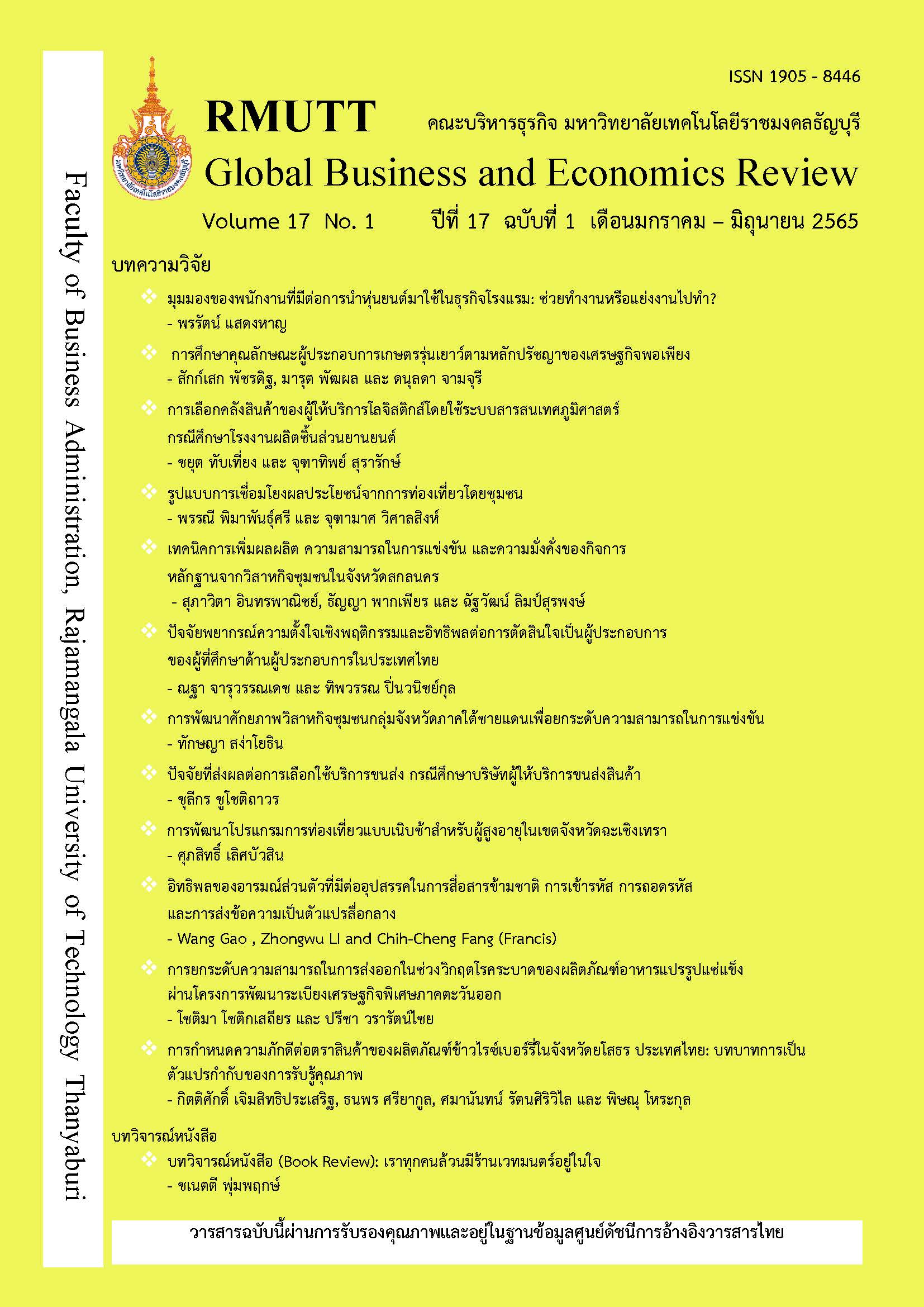มุมมองของพนักงานที่มีต่อการนำหุ่นยนต์มาใช้ในธุรกิจโรงแรม: ช่วยทำงานหรือแย่งงานไปทำ?
คำสำคัญ:
การยอมรับหุ่นยนต์ , การทำงานร่วมกันระหว่างหุ่นยนต์กับมนุษย์ , หุ่นยนต์บริการ , ธุรกิจโรงแรมบทคัดย่อ
การวิจัยเรื่องนี้มีวัตถุประสงค์เพื่อศึกษาถึงความคิดเห็นของผู้มีส่วนได้ส่วนเสียที่มีต่อการนำหุ่นยนต์มาใช้ในธุรกิจโรงแรมเขตพัฒนาพิเศษภาคตะวันออก โดยใช้วิธีการวิจัยแบบผสม ด้วยกลยุทธ์การสำรวจเป็นลำดับ ที่เริ่มจากการวิจัยเชิงคุณภาพก่อน เมื่อได้ผลการวิจัยเชิงคุณภาพแล้ว นำผลที่ได้ดังกล่าวไปพัฒนาเป็นแบบสอบถามในการวิจัยเชิงปริมาณ ซึ่งผลวิจัยเชิงคุณภาพพบว่า ผู้มีส่วนได้ส่วนเสียในการนำหุ่นยนต์มาใช้ในธุรกิจโรงแรมเขตพัฒนาพิเศษภาคตะวันออกให้การยอมรับกับการนำหุ่นยนต์มาใช้ และมีปัจจัยที่เกี่ยวข้อง ประกอบด้วยปัจจัยด้านมนุษย์ ด้านหุ่นยนต์ และด้านองค์การ ซึ่งปัจจัยทั้ง 3 ด้านดังกล่าวยังมีผลต่อการทำงานร่วมกันระหว่างมนุษย์กับหุ่นยนต์ สำหรับการสำรวจความคิดเห็นของพนักงานที่มีต่อการนำหุ่นยนต์มาใช้ในธุรกิจโรงแรมเขตพัฒนาพิเศษภาคตะวันออก ซึ่งเป็นผลวิจัยเชิงปริมาณ พบว่า ผู้ตอบแบบสอบถามให้การยอมรับกับการนำหุ่นยนต์มาใช้ในระดับปานกลาง เห็นด้วยกับปัจจัยด้านหุ่นยนต์ระดับมาก เห็นด้วยกับปัจจัยด้านองค์การและปัจจัยด้านมนุษย์ในระดับปานกลาง ส่วนความเห็นที่มีต่อการทำงานร่วมกันระหว่างมนุษย์กับหุ่นยนต์นั้น ผู้ตอบแบบสอบถามเห็นด้วยในระดับมาก
References
Bagdasarov, Z., Martin, A. A., & Buckley, M. R. (2018). Working with robots: organizational consideration. Organizational Dynamics, 49(2), 1-8.
Bayne, K. M., & Parker, R. J. (2012). The introduction of robotics for New Zealand forestry operations: Forest sector employee perceptions and implications. Technology in Society, 34(2), 138-148.
Dahlin, E. (2019). Are robots stealing our jobs?. Sociological Research for a Dynamic World, 5, 1–14.
Decker, M., Fischer, M., & Ott, I. (2017, January). Service robotics and human labor: a first technology assessment of substitution and Cooperation. Robotics and Autonomous Systems, 87, 348-354.
Dietz, T., Pott, A., Hägele, M., & Verl, A. (2013, October) A new, uncertainty-aware cost-model for cost-benefit assessment of robot systems in IEEE ISR 2013 (pp. 1-6). Seoul, Korea (South): IEEE.
Dillman D. (2000). Mail and Internet surveys: The total design method (2nd ed.). New York: Wiley.
Hannola, L., Richter, A., Richter, S., & Stocker, A. (2018). Empowering production workers with digitally facilitated knowledge processes.
International Journal of Production Research, 56(2),1-15.
Holthaus, P., & Wachsmuth, S. (2021). It was a pleasure meeting you: Towards a holistic model of human–robot encounters. International Journal of Social Robotics, 13, 1729– 1745.
Hu, Y., Benallegue, M., Venture, G., & Yoshida, E. (2020). Interact with me: An exploratory study on interaction factors for active physical human-robot interaction. IEEE Robotics and Automation Letters, 99,1-1.
Ivanov, S. H., Webster, C., & Berezina, K. (2017). Adoption of robots and service automation by tourism and hospitality companies. Revista Turismo & Desenvolvimento, 27/28, 1501-1517.
Khaksar, S. M. S., Khosla, R., Chu, M. T., & Shahmehr, F. S. (2016). Service innovation using social robot to reduce social vulnerability among older people in residential care facilities. Technological Forecasting and Social Change, 113 Part B, 438-453.
Khosla, R., Nguyen, K., & Chu, M.T. (2014) Assistive robot enabled service architecture to support home-based dementia care in 2014 IEEE 7th International Conference on Service-Oriented Computing and Applications (pp. 73–80). Matsue, Japan: IEEE.
Li, D., Rau, P. L. P. & Li, Y. (2010). A cross-cultural study: Effect of robot appearance and task. International Journal of Social Robotics, 2, 175–186.
Lu, L., Cai, R., & Gursoy, D. (2019) Developing and validating a service robot integration willingness scale. International Journal of Hospitality Management, 80, 36–51.
McCartney, G. & McCartney, A. (2020). Rise of the machines: towards a conceptual service-robot research framework for the hospitality and tourism industry. International Journal of Contemporary Hospitality Management, 13(12), 3835-3851.
Moran, D. (2020). Introduction to phenomenology. London: Routledge.
Osawa, H., Ema, A., Hattori, H., Akiya, N., Kanzaki, N., Kubo, A., Koyama, T., & Ichise, R. (2017). Analysis of robot hotel: Reconstruction of works with robots. 26th IEEE International Symposium on Robot and Human Interactive Communication (RO-MAN), pp. 219-223.
Pan, Y., Okada, H., Uchiyama, T., & Susuki, K. (2015). On the reaction to robot’s speech in a hotel public space. International of Social Robotics, 7, 911-920.
Sung, J. Y., Christensen, H. I., & Grinter, R. E. (2009). Robots in the wild: understanding long-term use. 4th ACM/IEEE International Conference on Human-Robot Interaction (HRI), pp.45-52.
Turja, T. & Oksanen, A. (2019). Robot acceptance at work: a multilevel analysis based on 27 EU countries. International Journal of Social Robotics, 11, 679–689.
Weiss, A., Bernhaupt, R., Lankes, M., & Tscheligi, M. (2009). The USUS evaluation framework for human-robot interaction. 23rd Convention of the Society for the Study of Artificial Intelligence and Simulation of Behaviour, pp. 11-26.
Wirtz, J., Patterson, P. G., Kunz, W. H., Gruber, T., Lu, V. N., Paluch, S., & Martins, A. (2018). Brave new world: service robots in the frontline. Journal of Service Management, 29(5), 907–931.
Xu, S. T., Stienmetz, J., & Ashton, M. (2020). How will service robots redefine leadership in hotel management? a delphi approach. International Journal of Contemporary Hospitality Management, 32, 2217–2237.
Downloads
เผยแพร่แล้ว
How to Cite
ฉบับ
บท
License
Copyright (c) 2022 พรรัตน์ แสดงหาญ

This work is licensed under a Creative Commons Attribution-NonCommercial-NoDerivatives 4.0 International License.
บทความที่ได้รับการตีพิมพ์เป็นลิขสิทธิ์ของผู้นิพนธ์
ข้อความที่ปรากฏในบทความแต่ละเรื่องในวารสารวิชาการเล่มนี้เป็นความคิดเห็นส่วนตัวของผู้เขียนแต่ละท่านไม่เกี่ยวข้องกับมหาวิทยาลัยเทคโนโลยีราชมงคลธัญบุรี และคณาจารย์ท่านอื่นๆในมหาวิทยาลัยฯ แต่อย่างใด ความรับผิดชอบองค์ประกอบทั้งหมดของบทความแต่ละเรื่องเป็นของผู้เขียนแต่ละท่าน หากมีความผิดพลาดใดๆ ผู้เขียนแต่ละท่านจะรับผิดชอบบทความของตนเองแต่ผู้เดียว







